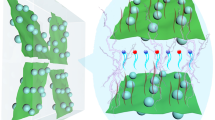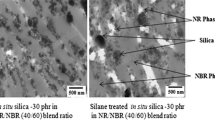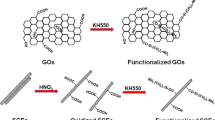Abstracts
Hybrid silica-graphene oxide (SiO2@GO) nanocomposites were fabricated by sol-gel method using tetraethylorthosilicate (TEOS) as silica (SiO2) precursor. The prepared nanocomposites were characterized by various analytical techniques to prove that the SiO2 were completely incorporated on the GO surface. Then, the SiO2@GO nanocomposites were introduced into natural rubber (NR) matrix followed by conventional vulcanization process, performed by two-roll mill, to obtain NR/SiO2@GO vulcanizate. The results showed that the presence of SiO2 nanoparticles on the GO surface improved the distribution of GO in NR matrix, resulting in the increase in modulus and hardness. For comparison with neat NR, NR/SiO2, and NR/GO, the network parameters of vulcanizates were evaluated using swelling test and tube model theory contributed in stress-strain measurement. These exhibited that the SiO2@GO induced the chemical crosslink between NR chains, leading to the increment in crosslink density. It was because the well dispersion of SiO2@GO in NR matrix improved the volume fraction of rubber. Moreover, dynamic mechanical analysis was employed to determine the viscoelasticity behavior of the vulcanizates. The results showed that the presence of SiO2@GO in NR vulcanizate improved the storage modulus in all temperature range. That meant the elasticity of the vulcanizates was improved by the reduction of the viscous phase to stiff phase ratio of the material. However, the reinforcement of NR using SiO2@GO as filler was effective in lower deformation reflected from higher modulus at low strain. In addition, the modulus decreased in comparison with that of the neat NR under higher deformation until at break point. Thus, the tensile strength decreased while elongation at break increased. This phenomenon might be explained that the strain-induced crystallization of NR occurred under higher strain was reduced because the rubber chains alignment which was obstructed by the filler penetration and high number of chemical crosslinks. Therefore, the covalent hybrid SiO2@GO nanocomposites had potential for use as filler in engineering rubber composites that were suitable for the compressive or abrasive applications.








Similar content being viewed by others
References
Oleiwi J, Hamza M, Almtteri N (2011) A study of the effect of carbon black powder on the physical properties of SBR/NR blends used in passenger tire treads. Vol. 29:856–870
Wei T, Song L, Zheng C, Wang K, Yan J, Shao B, Fan ZJ (2010) The synergy of a three filler combination in the conductivity of epoxy composites. Mater Lett 64(21):2376–2379
Hilonga A, Kim JK, Sarawade PB, Quang DV, Shao GN, Elineema G, Kim HT (2012) Synthesis of mesoporous silica with superior properties suitable for green tire. J Ind Eng Chem 18(5):1841–1844
Leblanc JL (2002) Rubber–filler interactions and rheological properties in filled compounds. Prog Polym Sci 27(4):627–687
Kiew SF, Kiew LV, Lee HB, Imae T, Chung LY (2016) Assessing biocompatibility of graphene oxide-based nanocarriers: a review. J Control Release 226:217–228
Emtsev KV, Bostwick A, Horn K, Jobst J, Kellogg GL, Ley L, McChesney JL, Ohta T, Reshanov SA, Röhrl J, Rotenberg E, Schmid AK, Waldmann D, Weber HB, Seyller T (2009) Towards wafer-size graphene layers by atmospheric pressure graphitization of silicon carbide. Nat Mater 8:203–207
Kim KS, Zhao Y, Jang H, Lee SY, Kim JM, Kim KS, Ahn JH, Kim P, Choi JY, Hong BH (2009) Large-scale pattern growth of graphene films for stretchable transparent electrodes. Nature 457:706–710
Li D, Müller MB, Gilje S, Kaner RB, Wallace GG (2008) Processable aqueous dispersions of graphene nanosheets. Nat Nanotechnol 3:101–105
Stolyarova E et al (2007) High-resolution scanning tunneling microscopy imaging of mesoscopic graphene sheets on an insulating surface. Vol. 104. 9209–12
Geim AK, Novoselov KS (2007) The rise of graphene. Nat Mater 6:183–191
Ke Q, Wang J (2016) Graphene-based materials for supercapacitor electrodes – a review. J Mater 2(1):37–54
Ji X, Xu Y, Zhang W, Cui L, Liu J (2016) Review of functionalization, structure and properties of graphene/polymer composite fibers. Compos A: Appl Sci Manuf 87:29–45
Aghigh A, Alizadeh V, Wong HY, Islam MS, Amin N, Zaman M (2015) Recent advances in utilization of graphene for filtration and desalination of water: a review. Desalination 365:389–397
Akinwande D, Brennan CJ, Bunch JS, Egberts P, Felts JR, Gao H, Huang R, Kim JS, Li T, Li Y, Liechti KM, Lu N, Park HS, Reed EJ, Wang P, Yakobson BI, Zhang T, Zhang YW, Zhou Y, Zhu Y (2017) A review on mechanics and mechanical properties of 2D materials—Graphene and beyond. Extreme Mechanics Letters 13:42–77
Rasheed AK, Khalid M, Rashmi W, Gupta TCSM, Chan A (2016) Graphene based nanofluids and nanolubricants – review of recent developments. Renew Sust Energ Rev 63:346–362
Zhao Y, Li XG, Zhou X, Zhang YN (2016) Review on the graphene based optical fiber chemical and biological sensors. Sensors Actuators B Chem 231:324–340
Kim H, Abdala AA, Macosko CW (2010) Graphene/polymer nanocomposites. Macromolecules 43(16):6515–6530
Wu L et al (2014) Green synthesis of reduced graphene oxide and its reinforcing effect on natural rubber composites. High Performance Polymers 27(4):486–496
Zhan Y, Wu J, Xia H, Yan N, Fei G, Yuan G (2011) Dispersion and exfoliation of Graphene in rubber by an ultrasonically-assisted latex mixing and in situ reduction process. Macromol Mater Eng 296(7):590–602
Guezzout Z, Doufnoune R, Haddaoui N (2017) Effect of graphene oxide on the properties of compatibilized polypropylene/ethylene-propylene-rubber blend. J Polym Res 24(8):129
Huang T-M, Lin CK, Wu RJ, Liu YT, Hsieh WY, Chang JH (2019) Development of segregated 3D graphene networks in rubber nanocomposites with enhanced electrical and mechanical properties. J Polym Res 26(5):122
Kam K-W et al (2017) Comparison study: effect of un-vulcanized and vulcanized NR content on the properties of two-matrix filled epoxy/natural rubber/graphene nano-platelets system. J Polym Res 25(1):15
Xing W, Tang M, Wu J, Huang G, Li H, Lei Z, Fu X, Li H (2014) Multifunctional properties of graphene/rubber nanocomposites fabricated by a modifiled latex compounding method. Compos Sci Technol 99:67–74
Li J, Yu K, Qian K, Cao H, Lu X, Sun J (2014) The situ preparation of silica nanoparticles on the surface of functionalized graphene nanoplatelets. Nanoscale Res Lett 9(1):172
Lin Y, Liu S, Peng J, Liu L (2016) The filler–rubber interface and reinforcement in styrene butadiene rubber composites with graphene/silica hybrids: a quantitative correlation with the constrained region. Compos A: Appl Sci Manuf 86:19–30
Zhang WL, Choi HJ (2012) Silica-graphene oxide hybrid composite particles and their electroresponsive characteristics. Langmuir 28(17):7055–7062
Kim J, Oh C, Chae C, Yeom DH, Choi J, Kim N, Oh ES, Lee JK (2015) 3D Si/C particulate nanocomposites internally wired with graphene networks for high energy and stable batteries. J Mater Chem A 3(36):18684–18695
Zhao G, Zhang L, Meng Y, Zhang N, Sun K (2013) Decoration of graphene with silicon nanoparticles by covalent immobilization for use as anodes in high stability lithium ion batteries. J Power Sources 240:212–218
Heidari N, Ghiasvand A, Abdolhosseini S (2017) Amino-silica/graphene oxide nanocomposite coated cotton as an efficient sorbent for needle trap device. Anal Chim Acta 975:1–9
Shitre PV et al (2016) Silica nanosphere–graphene oxide (SiO2–GO) hybrid catalyzed facile synthesis of functionalized quinoxaline derivatives. Res Chem Intermed 43(2):829–841
Peng L, Zhang J, Yang S, Han B, Sang X, Liu C, Ma X, Yang G (2015) Ultra-small gold nanoparticel immobilized on mesoporous silica/graphene oxide as highly active and stable heterogeneous catalysts. Chem Commun 51:4398–4401
Chen L, Chai S, Liu K, Ning N, Gao J, Liu Q, Chen F, Fu Q (2012) Enhanced epoxy/silica composites mechanical properties by introducing graphene oxide to the interface. ACS Appl Mater Interfaces 4(8):4398–4404
Luo F, Chen L, Ning N, Wang K, Chen F, Fu Q (2012) Interfacial enhancement of maleated polypropylene/silica composites using graphene oxide. J Appl Polym Sci 125(S1):E348–E357
Wang JC, Chen P, Chen L, Wang K, Deng H, Chen F, Zhang Q, Fu Q (2012) Preparation and properties of poly(vinylidene fluoride) nanocomposites blended with graphene oxide coated silica hybrids. Express Polym Lett 6(4):299–307
Zhao S, Xie S, Liu X, Shao X, Zhao Z, Xin Z, Li L (2018) Covalent hybrid of graphene and silicon dioxide and reinforcing effect in rubber composites. J Polym Res 25(10):225
Yoon CM, Lee S, Hong SH, Jang J (2015) Fabrication of density-controlled graphene oxide-coated mesoporous silica spheres and their electrorheological activity. J Colloid Interface Sci 438:14–21
Ma Y, di H, Yu Z, Liang L, Lv L, Pan Y, Zhang Y, Yin D (2016) Fabrication of silica-decorated graphene oxide nanohybrids and the properties of composite epoxy coatings research. Appl Surf Sci 360:936–945
Ramezanzadeh B, Haeri Z, Ramezanzadeh M (2016) A facile route of making silica naoparticles-covered graphene oxide nanohybrids (SiO2-GO); fabrication of SiO2-GO/epoxy composite coating with superior barrier and corrosion protection performance. Chem Eng J 303:511–528
Deerattrakul V, Dittanet P, Sawangphruk M, Kongkachuichay P (2016) CO2 hydrogenation to methanol using Cu-Zn catalyst supported on reduced graphene oxide nanosheets. Journal of CO2 Utilization 16:104–113
Flory PJ, Rehner J (1943) Statistical mechanics of cross-linked polymer networks II. Swelling. The Journal of Chemical Physics 11(11):521–526
Qu L, Yu G, Xie X, Wang L, Li J, Zhao Q (2013) Effect of silane coupling agent on filler and rubber interaction of silica reinforced solution styrene butadiene rubber. Polym Compos 34(10):1575–1582
Liu Z, Zhang H, Song S, Zhang Y (2017) Improving thermal conductivity of styrene-butadiene rubber composites by incorporating mesoporous silica@solvothermal reduced graphene oxide hybrid nanosheets with low graphene content. Compos Sci Technol 150:174–180
Zhou X, Shi T (2012) One-pot hydrothermal synthesis of a mesoporous SiO2–graphene hybrid with tunable surface area and pore size. Appl Surf Sci 259:566–573
Xue X, Yin Q, Jia H, Zhang X, Wen Y, Ji Q, Xu Z (2017) Enhancing mechanical and thermal properties of styrene-butadiene rubber/carboxylated acrylonitrile butadiene rubber blend by the usage of graphene oxide with diverse oxidation degrees. Appl Surf Sci 423:584–591
Jafari AJ, Kalantary RR, Esrafili A, Arfaeinia H (2018) Synthesis of silica-functionalized graphene oxide/ZnO coated on fiberglass and its application in photocatalytix removal of gaseous. Process Saf Environ Prot 116:377–387
Kazemi E, Haji Shabani AM, Dadfarnia S (2017) Application of graphene oxide-silica composite reinforced hollow fibers as a novel device for pseudo-stir bar solid phase microextraction of sulfadiazine in different matrices prior to its spectrophotometric determination. Food Chem 221:783–789
Hintze C, Morita K, Riedel R, Ionescu E, Mera G (2016) Facile sol–gel synthesis of reduced graphene oxide/silica nanocomposites. J Eur Ceram Soc 36(12):2923–2930
Singh VK, Elomaa O, Johansson LS, Hannula SP, Koskinen J (2014) Lubricating properties of silica/graphene oxide composite powders. CARBON 79:227–235
Lei Y, Hu Z, Cao B, Chen X, Song H (2017) Enhancements of thermal insulation and mechanical property of silica aerogel monoliths by mixing graphene oxide. Mater Chem Phys 187:183–190
Chen S, du X, Jia L, Chang H, Ikoma T, Hanagata N (2016) Synthesis and osteo-compatibility of novel reduced graphene oxide-aminosilica hybrid nanosheets. Mater Sci Eng C Mater Biol Appl 61:251–256
Perumal S, Park KT, Lee HM, Cheong IW (2016) PVP-b-PEO block copolymers for stable aqueous and ethanolic graphene dispersions. J Colloid Interface Sci 464:25–35
Ghosh R, Singh A, Santra S, Ray SK, Chandra A, Guha PK (2014) Highly sensitive large-area multi-layered graphene-based flexible ammonia sensor. Sensors Actuators B Chem 205:67–73
She X, He C, Peng Z, Kong L (2014) Molecular-level dispersion of graphene into epoxidized natural rubber: morphology, interfacial interaction and mechanical reinforcement. Polymer 55(26):6803–6810
Chen J, Yao B, Li C, Shi G (2013) An improved hummers method for eco-friendly synthesis of graphene oxide. Carbon 64:225–229
Wu P-H, Yu XY, Cheng CW, Liao CH, Feng SW, Wang HC (2011) Ultrafast ablation dynamics in fused silica with a white light beam probe. Opt Express 19(17):16390–16400
Malas A, Das CK, Das A, Heinrich G (2012) Development of expanded graphite filled natural rubber vulcanizates in presence and absence of carbon black: mechanical, thermal and morphological properties. Mater Des 39:410–417
Ahmed K, Nizami SS, Raza NZ (2013) Characteristics of natural rubber hybrid composites based on marble sludge/carbon black and marble sludge/rice husk derived silica. J Ind Eng Chem 19(4):1169–1176
Kang H, Tang Y, Yao L, Yang F, Fang Q, Hui D (2017) Fabrication of graphene/natural rubber nanocomposites with high dynamic properties through convenient mechanical mixing. Compos Part B 112:1–7
Edwards SF, Vilgis TA (1988) The tube model theory of rubber elasticity. Rep Prog Phys 51(2):243–297
Faraji G, Kim HS, Kashi HT (2018) Chapter 7 - mechanical properties of ultrafine-grained and nanostructured metals, in Severe Plastic Deformation, G. Faraji, H.S. Kim, and H.T. Kashi, Editors. Elsevier. p. 223–257
Marzocca AJ, Cerveny S, Raimondo RB (1997) Analysis of the variation of molecular parameters of NR during vulcanization in the frame of the conformational tube model. J Appl Polym Sci 66(6):1085–1092
López-Manchado MA, Valentín JL, Carretero J, Barroso F, Arroyo M (2007) Rubber network in elastomer nanocomposites. Eur Polym J 43(10):4143–4150
Heinrich G, Vilgis T (1993) Contribution of entanglements to the mechanical properties of carbon black-filled polymer networks. Macromolecules 26(5):1109–1119
Plagge J, Klüppel M (2018) Determining strain-induced crystallization of natural rubber composites by combined thermography and stress-strain measurements. Polym Test 66:87–93
Spratte T, Plagge J, Wunde M, Klüppel M (2017) Investigation of strain-induced crystallization of carbon black and silica filled natural rubber composites based on mechanical and temperature measurements. Polymer 115:12–20
Yan N, Buonocore G, Lavorgna M, Kaciulis S, Balijepalli SK, Zhan Y, Xia H, Ambrosio L (2014) The role of reduced graphene oxide on chemical, mechanical and barrier properties of natural rubber composites. Compos Sci Technol 102:74–81
Nie Y, Huang G, Qu L, Wang X, Weng G, Wu J (2011) New insights into thermodynamic description of strain-induced crystallization of peroxide cross-linked natural rubber filled with clay by tube model. Polymer 52(14):3234–3242
Acknowledgements
This research is supported in part by the Graduate Program Scholarship from the Graduate School, Kasetsart University. Authors are sincerely thankful to Center of Excellence-Oil Palm, Department of Chemistry, Kasetsart University and Kasetsart University Research and Development Institute (KURDI), Kasetsart University for financial support. Authors wish to thank Specialized center of Rubber and Polymer Materials for agriculture and industry (RPM), Faculty of Science, Kasetsart University for the presentation support.
Author information
Authors and Affiliations
Corresponding author
Ethics declarations
Conflict of interest
Methus Charoenchai, Siree Tangbunsuk, and Wirunya Keawwattana declare that they have no conflicts of interest.
Additional information
Publisher’s note
Springer Nature remains neutral with regard to jurisdictional claims in published maps and institutional affiliations.
Rights and permissions
About this article
Cite this article
Charoenchai, M., Tangbunsuk, S. & Keawwattana, W. Silica-graphene oxide nanohybrids as reinforcing filler for natural rubber. J Polym Res 27, 230 (2020). https://doi.org/10.1007/s10965-020-02209-y
Published:
DOI: https://doi.org/10.1007/s10965-020-02209-y




